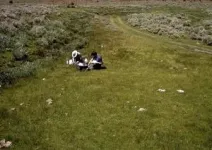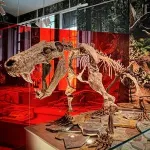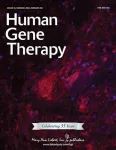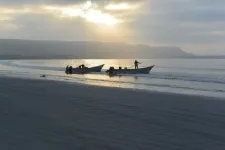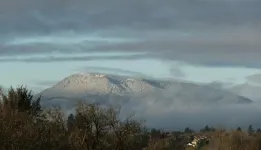(Press-News.org) RENO, Nev. – A multi-agency study, spearheaded by researchers from the University of Nevada, Reno’s College of Agriculture, Biotechnology & Natural Resources and the U.S. Department of Agriculture, underscores the impacts of strategic cattle grazing, particularly on restoring the declining population of the greater sage-grouse bird, a keystone species in the Great Basin region.
Amidst ongoing decline, the U.S. Fish and Wildlife Service acted by listing the sage-grouse for protection under the Endangered Species Act in 2011. This move prompted the Bureau of Land Management to develop a federal conservation plan for the species in 2015. Simultaneously, the World Wildlife Fund classified the sage-grouse as “near-threatened” in 2014, signifying its concern about the species’ potential future extinction.
According to the study, the intensity and timing of grazing throughout the year has a significant impact on the availability of certain insects and plants that serve as vital food sources for the species, particularly during their reproductive phase. The insects, including beetles, moths, ants, grasshoppers and butterflies, are a key source of food for the species’ hatchlings in their first three weeks of life, while the flowering plants, known as forbs, provide nutritional benefits, especially for nesting birds.
“While many studies have explored various methods to restore greater sage-grouse populations, including restricting petroleum drilling in their habitats, our research specifically focused on enhancing the food supply within mountain meadow systems, which are key habitat for wildlife,” said William Richardson, the study’s lead researcher and a postdoctoral scholar in the College’s Department of Agriculture, Veterinary & Rangeland Science. "Protecting these birds, however, requires a holistic approach that ultimately extends to fostering the growth of insects, which serve as crucial food sources, pollination agents and more."
The sagebrush desert and shrubland are the predominant plant species in much of the Great Basin. However, a U.S. Geological Survey report indicates that nearly half of the region’s rangelands have been lost due to widespread habitat destruction, primarily from wildland fire. Native species such as the sage-grouse rely on this ecosystem for food and nesting and can survive nowhere else.
The study’s findings were first published in October 2021 in the Journal of Remote Sensing and later in December 2023 in the Journal of Environmental Management. The study, conducted between 2019 and 2021, assessed the impact of three grazing intensities on seven Great Basin meadows with varying vegetation cover in central Nevada. To monitor the proliferation of insects and plants on pastured meadows on a larger scale, the study employed the use of high-resolution digital cameras designed to capture time-lapse images of foliage over longer duration. They are commonly referred to as phenocams.
“These cameras allowed us to make real-time observations and collect data simultaneously over the study’s two-year period,” Richardson said. “They typically track plant lifecycles with high accuracy and offer a more practical way to make longitudinal observations in ecological research.”
At the end of the two-year observation period, data showed that an increase in grazing during the spring and summer had a significant impact on the vegetation communities in the meadow systems, with higher grazing intensities affecting the length of the growing season. This timing coincided with the breeding season of sage-grouse, during which the nesting birds depend on the flowering plants for food.
“This is an important finding as it emphasizes the sage-grouse’s high sensitivity to disturbance, especially when they are hatching and caring for their young ones,” Richardson said.
The study also found that grazing intensity was not ultimately detrimental to insect abundance, and even permitted some insects to thrive. Specifically, beetles were found in higher numbers when grazing occurred in both wet and relatively drier seasons, while the moths and butterflies showed an increase in population during the wetter seasons.
“Our results show that strategic grazing has the potential to have a positive impact on the biodiversity of meadow habitat, which not only benefits other species, but more so the sage-grouse, which is high up in the sagebrush food chain,” he said.
Other members of the research team include Professor Tamzen K. Stringham and Associate Professor Andrew Nuss from the College’s Department of Agriculture, Veterinary & Rangeland Sciences, Postdoctoral Scholar Brian Morra from the College’s Department of Natural Resources & Environmental Science and Keirith A. Snyder from the U.S. Department of Agriculture’s Great Basin Rangeland Research Unit. Stringham, Nuss and Morra also conduct research as part of the College’s Experiment Station. The team received funding and technical support from the Nevada Department of Wildlife, the U.S. Geological Survey and the Bureau of Land Management.
The shifting protection policies for the sage-grouse species
With sagebrush ecosystems as their only home, environmental experts have long considered the well-being of sage-grouse as a barometer for the overall health of the sagebrush ecosystems. In fact, according to the U.S. Department of Agriculture’s Natural Resources Conservation Service, a healthy sage-grouse population, restored through the restoration of its habitat, also supports 350 other sagebrush-dependent species, such as elk, deer, mule, pygmy rabbit and pronghorn, and nearly 200 migratory and resident bird species. Any decline in the species’ population, therefore, acts as a natural alarm for an imbalanced sagebrush ecosystem.
“The entire sage-grouse habitat is in the Western United States, and much of that land is publicly owned and managed by the federal government for purposes of conservation and development of natural resources, grazing and recreation,” said Brian Morra, a soil ecology postdoctoral scholar in the University’s Department of Natural Resources & Environmental Science, and a member of the research team. “Given this extensive federal involvement, research findings from publicly funded scientists, such as those presented in this study, play a crucial role in informing and supporting the habitat’s conservation policies.”
Despite numerous scientific appeals for the preservation of sagebrush-dependent species such as the sage-grouse and repeated warnings of their declining population from conservationists, federal support that mainly focuses on sage-grouse populations rather than the ecosystem health at large is an inconsistency that Morra cites as potentially detrimental to the long-term health of sage-grouse and the sagebrush ecosystems.
"It's disheartening to witness the challenges we face in achieving long-term sustainability for these ecosystems,” said Morra, whose research focuses on grazing management and soil health. “Regulatory support that considers ecosystem-level effects is crucial for advancing efforts towards preservation and ensuring a healthy future for generations to come."
The bi-state sage-grouse, a variety of the greater sage-grouse that is exclusive to Nevada and California, has had its own share of conservation drama. It is undergoing its third assessment in a decade for potential protection under the Endangered Species Act. With a dwindling population of approximately 3,300 birds, only half of its count 150 years ago, the bi-state sage-grouse continues to confront the same challenges, notably pinyon-juniper encroachment and decreasing viable habitat.
"The plight of the bi-state sage-grouse demonstrates the urgent need for comprehensive conservation action for the species," said Morra. “Scientific findings like this one must be amplified, and regulations need to be aligned with such findings to strike a balance between the needs of ecosystems and those of humans who use them.”
Funding for the project came from the Bureau of Land Management Carson City Nevada District; the Bureau of Land Management Nevada State Office; and the University of Nevada, Reno Great Basin Sagebrush Restoration Fund. Additional support was provided by the Bureau of Land Management through the Soil, Water and Riparian Monitoring and Research in Nevada, as well as the Nevada Forest and Rangeland Research Project: Desatoya Meadows sage-grouse habitat under the Great Basin Cooperative Ecosystem Studies Unit. The Nevada Department of Wildlife provided fencing installation for the study, and the U.S. Geological Survey helped in collecting sage-grouse data.
END
Strategic grazing could boost conservation of ‘near-threatened’ sage-grouse
University of Nevada, Reno researchers link strategic grazing to increased food supply for the species
2024-02-23
ELSE PRESS RELEASES FROM THIS DATE:
Complement system response to AAV vector gene therapy
2024-02-23
Recent clinical trials utilizing high doses of adeno-associated virus (AAV) vectors have highlighted a new challenge to AAV gene transfer – activation of the complement system. A new article in the peer-reviewed journal Human Gene Therapy describes how a convergence of AAV-specific, environmental, and patient-specific factors shaping complement responses likely contribute to differential outcomes seen in clinical trials. Click here to read the article now.
Complement responses may contribute to priming of the adaptive immune system or serious adverse events ...
Study suggests people in urban areas with more green space have better mental health
2024-02-23
By Ann Kellett, Texas A&M University School of Public Health
A new study from the Texas A&M University School of Public Health suggests that city dwellers who have more exposure to urban green spaces require fewer mental health services.
The study, published in the International Journal of Environmental Research and Public Health, was conducted by Jay Maddock, Ph.D., Regents Professor of environmental and occupational health at Texas A&M, and colleagues from the Center ...
Zinc discovery holds promise for people with cystic fibrosis
2024-02-23
University of Queensland researchers have identified an opportunity to reduce infections in people living with cystic fibrosis.
Professor Matt Sweet, Dr Kaustav Das Gupta and Dr James Curson from UQ’s Institute for Molecular Bioscience have discovered a fault in the bacteria-killing function of immune cells in people with CF and a potential way to get around it.
CF is a chronic disease in which defects in the CFTR (cystic fibrosis transmembrane conductance regulator) channel cause a build-up of mucus in the lungs, airways and digestive system, leading to ...
Study finds black children in UK at four times greater risk of complications following emergency appendicitis surgery compared with white children
2024-02-23
New research published in Anaesthesia (the journal of the Association of Anaesthetists) shows that for children undergoing emergency surgery for appendicitis in the UK, black children had a four times greater risk of postoperative complications compared with white children. The study was led by Dr Amaki Sogbodjor, from Great Ormond Street Hospital and University College London (UCL), and Professor Ramani Moonesinghe, UCL Division of Surgery and Interventional Science, London, UK and Director, Central London National ...
Webb finds evidence for neutron star at heart of young supernova remnant
2024-02-22
NASA’s James Webb Space Telescope has found the best evidence yet for emission from a neutron star at the site of a recently observed supernova. The supernova, known as SN 1987A, was a core-collapse supernova, meaning the compacted remains at its core formed either a neutron star or a black hole. Evidence for such a compact object has long been sought, and while indirect evidence for the presence of a neutron star has previously been found, this is the first time that the effects of high-energy ...
Study finds guided parent-child discussions are effective at addressing subtle racism
2024-02-22
Study finds guided parent-child discussions are effective at addressing subtle racism
When parents discuss racism with their children, negative biases toward Black people are significantly reduced in both parent and child
EVANSTON, Ill. --- Experts have long pointed out the need for white parents to have conversations that directly address racism with their children to reduce racial bias. But many parents fail to have these crucial discussions.
Psychology researchers at Northwestern University have published ...
Entrepreneurs’ stock losses bruise their businesses
2024-02-22
When a recession takes a bite out of an entrepreneur’s personal stock portfolio, does that person’s business suffer more than those of older and larger competitors?
New research by Marius Ring, assistant professor of finance at Texas McCombs, finds a link between the wealth of small-business owners and the health of their companies during economic downturns. When their stock portfolios lose value, their businesses suffer ripple effects: less financing and curtailed hiring.
“Entrepreneurial wealth follows the ups and downs of economic cycles,” Ring says. “I show that for entrepreneurs whose stock portfolios take a hit, their businesses ...
Copies of antibiotic resistance genes greatly elevated in humans and livestock
2024-02-22
DURHAM, N.C. – Biomedical engineers at Duke University have uncovered a key link between the spread of antibiotic resistance genes and the evolution of resistance to new drugs in certain pathogens.
The research shows bacteria exposed to higher levels of antibiotics often harbor multiple identical copies of protective antibiotic resistance genes. These duplicated resistance genes are often linked to “jumping genes” called transposons that can move from strain to strain. Not only does this provide a mechanism for resistance to spread, having multiple copies of a resistance ...
Study shows how local fishers respond to climate challenges
2024-02-22
BEAUFORT, N.C. – When it comes to protecting a crucial resource in the face of changing conditions, it’s important to know how the humans reliant on that resource have organized themselves. Especially if there isn’t a lot of government supervision.
A new study of small-scale fisheries in Mexico’s Gulf of California has found that the fishers’ response to a changing climate can be strongly influenced by what they fish for and how they’re organized. The work appears in the January 2024 issue of Global Environmental Change.
“When we ...
Cooler, wetter parts of Pacific Northwest likely to see more fires, new simulations predict
2024-02-22
CORVALLIS, Ore. – Forests in the coolest, wettest parts of the western Pacific Northwest are likely to see the biggest increases in burn probability, fire size and number of blazes as the climate continues to get warmer and drier, according to new modeling led by an Oregon State University scientist.
Understanding how fire regimes may change under future climate scenarios is critical for developing adaptation strategies, said the study’s lead author, Alex Dye.
Findings were published today in JGR Biogeosciences.
Dye, ...
LAST 30 PRESS RELEASES:
New modeling approach sheds light on rare gut disease
Study documents potentially hazardous flame retardants in firefighter gear
Can certain bacteria regulate aging of the immune system and its related alterations?
AI model helps diagnose often undetected heart disease from simple EKG
There are fewer online trolls than people think
Cell membrane fluctuations produce electricity
Jeonbuk National University study shows positive parenting can protect adolescents against self-harm
Surface-engineered ZnO nanocrystals to tackle perfluoroalkyl substance contamination
This new understanding of T cell receptors may improve cancer immunotherapies
A new fossil face sheds light on early migrations of ancient human ancestor
A new immunotherapy approach could work for many types of cancer
A new way to diagnose deadly lung infections and save lives
40 percent of MRI signals do not correspond to actual brain activity
How brain-inspired algorithms could drive down AI energy costs
Gum disease may be linked to plaque buildup in arteries, higher risk of major CVD events
Contrails are a major driver of aviation’s climate impact
Structure of dopamine-releasing neurons relates to the type of circuits they form for smell-processing
Reducing social isolation protects the brain in later life
Keeping the heart healthy increases longevity even after cancer
Young adults commonly mix cannabis with nicotine and tobacco
Comprehensive review illuminates tau protein's dual nature in brain health, disease, and emerging psychiatric connections
Book prepares K-12 leaders for the next public health crisis
Storms in the Southern Ocean mitigates global warming
Seals on the move: Research reveals key data for offshore development and international ecology
Sports injuries sustained during your period might be more severe
World's first successful 2 Tbit/s free-space optical communication using small optical terminals mountable on satellites and HAPS
Can intimate relationships affect your heart? New study says ‘yes’
Scalable and healable gradient textiles for multi‑scenario radiative cooling via bicomponent blow spinning
Research shows informed traders never let a good climate crisis go to waste
Intelligent XGBoost framework enhances asphalt pavement skid resistance assessment
[Press-News.org] Strategic grazing could boost conservation of ‘near-threatened’ sage-grouseUniversity of Nevada, Reno researchers link strategic grazing to increased food supply for the species

